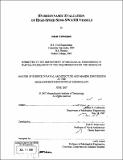| dc.contributor.advisor | Paul D. Sclavounos. | en_US |
| dc.contributor.author | Guttenplan, Adam (Adam David) | en_US |
| dc.contributor.other | Massachusetts Institute of Technology. Dept. of Mechanical Engineering. | en_US |
| dc.date.accessioned | 2007-12-07T16:13:28Z | |
| dc.date.available | 2007-12-07T16:13:28Z | |
| dc.date.copyright | 2007 | en_US |
| dc.date.issued | 2007 | en_US |
| dc.identifier.uri | http://hdl.handle.net/1721.1/39726 | |
| dc.description | Thesis (S.M. in Naval Architecture and Marine Engineering)--Massachusetts Institute of Technology, Dept. of Mechanical Engineering, 2007. | en_US |
| dc.description | Includes bibliographical references (p. 62). | en_US |
| dc.description.abstract | High-speed semi-displacement vessels have enjoyed rapid development and widespread use over the past 25 years. Concurrent with their growth as viable commercial and naval platforms, has been the advancement of three-dimensional computational fluid dynamics codes that simulate steady and unsteady free surface potential flows around ships. The most promising of these computer-based simulations employ a variation of the Rankine Panel Method, or R.P.M. R.P.M.'s offer greater prediction accuracy than industry standard two-dimensional strip and slender-body methods, and are enjoying increased use in practical vessel design due to their reliability and low relative cost. This study uses one such code to examine the high-speed hydrodynamic performance of a slender, semi-SWATH, prototype catamaran with variable demi-hull separation. Hull separation's influence on vessel performance was studied in terms of calm water resistance and seakeeping response in a bare-hull state, and when equipped with quasi-active lifting appendage control. Analysis was performed on a 10.5m, 10,000kg reduced waterplane area catamaran designed by Lockheed Martin Maritime Systems & Sensors. | en_US |
| dc.description.abstract | (cont.) In accordance with a non-disclosure agreement, specific hull geometry has been deemed proprietary and is not revealed. Principle vessel dimensions, body, and free surface meshing however, are discussed. The hydrodynamic characteristics of each hull separation and lifting appendage configuration were analyzed by the general purpose, potential flow, time domain, Rankine Panel Method, software package, SWAN2 2002. An acronym for Ship Wave ANalysis, SWAN2 2002 is a state-of-the-art computational fluid dynamics code developed in MIT in recent years, and is utilized principally as a numerical towing tank. | en_US |
| dc.description.statementofresponsibility | by Adam Guttenplan. | en_US |
| dc.format.extent | 71 p. | en_US |
| dc.language.iso | eng | en_US |
| dc.publisher | Massachusetts Institute of Technology | en_US |
| dc.rights | M.I.T. theses are protected by copyright. They may be viewed from this source for any purpose, but reproduction or distribution in any format is prohibited without written permission. See provided URL for inquiries about permission. | en_US |
| dc.rights.uri | http://dspace.mit.edu/handle/1721.1/7582 | |
| dc.subject | Mechanical Engineering. | en_US |
| dc.title | Hydrodynamic evaluation of high-speed semi-SWATH vessels | en_US |
| dc.type | Thesis | en_US |
| dc.description.degree | S.M.in Naval Architecture and Marine Engineering | en_US |
| dc.contributor.department | Massachusetts Institute of Technology. Department of Mechanical Engineering | |
| dc.identifier.oclc | 180934952 | en_US |
